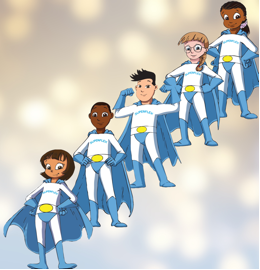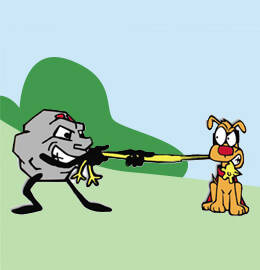Updated: April, 2022
© 2022 Think Social Publishing, Inc.
Social thinking is flexible thinking; how we navigate through many different social landscapes and adapt our behaviors to meet our own goals is what the Social Thinking® Methodology is all about. The Superflex® Curriculum is the tool for interventionists, but the concept of transforming oneself into their own superhero is introduced in a comic book about Rock Brain and other members of the Team of UnthinkaBots. The storybook is about Aiden’s discovery of how he can turn himself into Superflex Aiden. For the past 12 years, children all over the world have been learning metacognitive strategies as they imagine themselves as superheroes or superkids that look just like them. This means it is critical to teach every student that Superflex is Me! Emphasis is that their Superflex looks exactly like them – whatever their gender, race, body size, hair color, with glasses, wheelchair, or other characteristics unique to them. Each child’s Superflex is a mirror image of the child who is developing superflexible powers. Please see the free handout and video on our website.
Kids get to learn about and build their own Superflexible powers related to the 14 original UnthinkaBots (e.g., WasFunnyOnce, Me-Gull (formally One-Sided Sid), Worry Wall, Topic Twister Meister, Energy Hare-y, etc.). Both neurodivergent and neurotypical students have been active inventers (i.e., naming, describing, and figuring out powers) of even more imaginary characters or UnthinkaBots like Dark Defeatist, Picky Peter, Blurt Out Blue, and Rule Police. You can find examples of kid-, student-, client-created UnthinkaBots from around the world in Social Town Citizens Discover 82 New Unthinkables for Superflex to Outsmart.
Most, but not all, children adore the prankster ways of the UnthinkaBots, and find motivation to transform themselves into their own Superflex to live as a solid citizen in Social Town and the broader social world—whether it’s in their own families, schools, or communities. As part of the Superflex Curriculum, children are also encouraged to explore the powers of their own brain, including its ability to think metacognitively and flexibly to self-regulate and problem solve in the broader world and social world. This kind of thinking develops further self-awareness of which UnthinkaBot (i.e., thinking or behavior that can get in the way of learning or relating to others) may be lurking nearby. Children then learn to how to use metacognitive strategies to manage the powers of the UnthinkaBots through strategies we call Thinkables® (also imaginary creatures in our brains), thanks to encouragement from the mental health community.
As therapists and publishers of this work, we were thrilled by how many parents, teachers, and therapists not only use these materials, but also have expanded lessons to encourage metacognitive learning and social emotional self-regulation in 6- to 11-year-olds. Unfortunately, some interventionists (parents and professionals) used the Thinkables and Superflex characters to reward what they saw as “good” behavior and used the UnthinkaBots to shame or blame behaviors. This was certainly never our intention, but we also understand that metacognitive learning strategies are vastly different from behaviorally based strategies that might focus on how to get a child to “behave.” The differences between teaching children to “behave” versus teaching children to develop their own pathways toward self-regulation are summarized in the chart below:
Exploring Behavioral Teaching versus Social Emotional Learning
| Behaviorally based teaching strategies | Metacognitively based teaching strategies | |
| Overall focus |
The behavior is based on social stimuli and antecedents.
Behavioral approaches often use an acronym to represent the links between “ABC,” defined as antecedents, behavior, and then consequences of behavior. |
Develop thinking to expand social competencies based on moving towards one’s social goals; how one socially attends, interprets, problem solves, and responds to socially based stimuli. |
| Intervention strategies and rewards |
|
|
| Speed of learning and generalization | May show rapid outcomes that may fail to generalize beyond the context without additional prompts and cues and rewards. |
|
Using the Superflex Curriculum to teach social emotional learners continues to evolve as we learn more about what you, the interventionist, needs to support your students and clients. We know children love imagining themselves as they transform into their own Superflex superhero. We know they enjoy building their Thinkable powers and managing their own team of UnthinkaBots. We know you love teaching using this curriculum, but you’ve also asked for more visual supports in the form of stickers inspired by this crew of imaginary characters.
Superflex Super Sticker Collection: UnthinkaBots & Thinkables is a packet of over 500 stickers that showcase UnthinkaBots, Thinkables, and “Superflex is Me!” We added Blurt Out Blue (an UnthinkaBot theme that was submitted several times by neurodivergent students, their parents and teachers). We also added the Thinkable strategy to manage Blurt Out Blue, Thought Catcher. True to all teaching related to the Social Thinking Methodology, these stickers were not designed to be used as rewards or as a way to point out, shame, or punish a behavior. Instead, use these as visual tools to encourage a metacognitive focus and promote self-awareness of their own Thinkable powers, as well as the powers of the UnthinkaBots—all coexisting within their social learning brain. Here are some ideas for using this collection in your setting and things to avoid.
A few ideas for using the Superflex Super Sticker Collection: UnthinkaBots & Thinkables
| Type of Sticker | Recommended Use | What to Avoid! |
| Superflex is Me! sticker |
|
Do not use as a reward for a child stopping a behavior. |
| Thinkable stickers |
|
Avoid using stickers as a reward for being “good” or using desired behaviors. |
| Unthinkable stickers |
|
Do not use to call out, shame, or punish undesired behaviors. |
| Team of UnthinkaBots stickers |
|
Do not use to call out, shame, or punish undesired behaviors. |
| Team of Thinkables stickers |
Based on the team of UnthinkaBots selected:
|
Do not expect children to know how to manage UnthinkaBots without teaching Thinkable strategies first. |
While all children will eventually mature beyond the pretend world of Thinkables/UnthinkaBots and Superflex, most of us never outgrow learning about the power of our own social mind and its role in helping us to understand the social world and self-regulate to meet our own social goals. Some tweens and teens might still enjoy imagining video game-type UnthinkaBot or Thinkable characters to continue to grow their superflexible thinking while others will enjoy developing a board game or card deck of teenage UnthinkaBots/Thinkables.
At the end of the day, all materials developed as part of the Social Thinking Methodology promote a growth mindset and grit, along with learning metacognitive strategies for understanding how the social world works in order to learn to work (navigate to regulate) in the social world.












